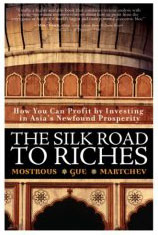 The Silk Road: A Positive Look at
Asia The Silk Road: A Positive Look at
Asia
Chip Hanlon
Delta Global Advisors
April 25, 2006
An outstanding book was just
released about the rising nations of Asia.
Now, I may be a bit biased
because I already know of and respect the work of a couple of
the book's authors (it was co-written by three: Yiannis Mostrous,
Elliott Gue and Ivan Martchev, editors of the Silk Road Investor,
Energy Strategist and Global Viewpoints newsletters, respectively).
I've also found that what I've
come to respect the most over time is balance. My commentaries
sometimes stir the pot a bit because I'll rail against arguments
from those I perceive to be stopped clocks; recently I've tended
to call out perma-bears, but I feel the same way about those
who can never seem to envision anything but sunny skies for the
economy and markets, folks who have historically been mainstream
Wall Street strategists.
What I prize most in other
commentators is a little nuance and a willingness to re-examine
and change one's opinions when called for. It's just my personal
preference.
This is why I think so highly
of "The
Silk Road to Riches: How you can Profit by Investing in Asia's
Newfound Prosperity," just released by Financial Times Prentice
Hall publishing.
With their expertise in energy
and international markets, do the authors acknowledge the strains
the rising Asian economies are putting on the world's natural
resources? Of course. They don't, however, go on to fill pages
with horror stories about how oil will soon run so dry, that
not only will nations go to war, but neighbor will fight neighbor
in a frantic battle for every drop, as at least one peak oil
book has literally predicted.
Do they assert that within
a generation China will become the world's largest economy? Indeed,
yet the authors are reasonable enough to also recognize that
for now, the nation is still reliant on U.S. consumption and
would be dramatically impacted by a meaningful consumer slowdown
here, as opposed to some who suggest that if U.S. consumption
went south, the Chinese wouldn't skip a beat, they'd simply start
consuming all their output themselves. With an under-developed
banking system and virtually non-existent credit markets, such
an assertion is just plain silly at present.
Broadly speaking, the authors
recognize today's enormous economic imbalances and the potential
threat to the U.S. Dollar as the world works toward a new global
pecking order, economically. Although China ends up at the top
of the list in time, the authors allow for a number of possible
paths that get us there; unstable as the path may be at times,
it isn't doom and gloom we're promised as a result. This book
sees the emergence of Asia broadly speaking as a positive for
East and West alike, which is refreshing.
And I'm not the only one who
thinks so. The book is quickly receiving high praise, including
from the likes of Dr. Marc Faber, who says, "Finally...
a book that combines serious analysis with specific investment
recommendations... about the world's largest and most powerful
economies."
Well said. The
Silk Road to Riches is the perfect book for these most interesting
economic times in which we live.
**Many investors who are wary
of U.S. markets are looking abroad for opportunities. For an
exclusive, in-depth report on the most important Asian economies,
be sure to download our free report on China, India and Japan
here:
http://www.deltaga.com/reportForm.asp?rep=3
Chip Hanlon
President
website: Delta Global Advisors
email: chanlon@deltaga.com
800-485-1220
Chip Hanlon
is currently the President of Delta Global Advisors and the founder of
Green
Faucet.
321gold Inc

|